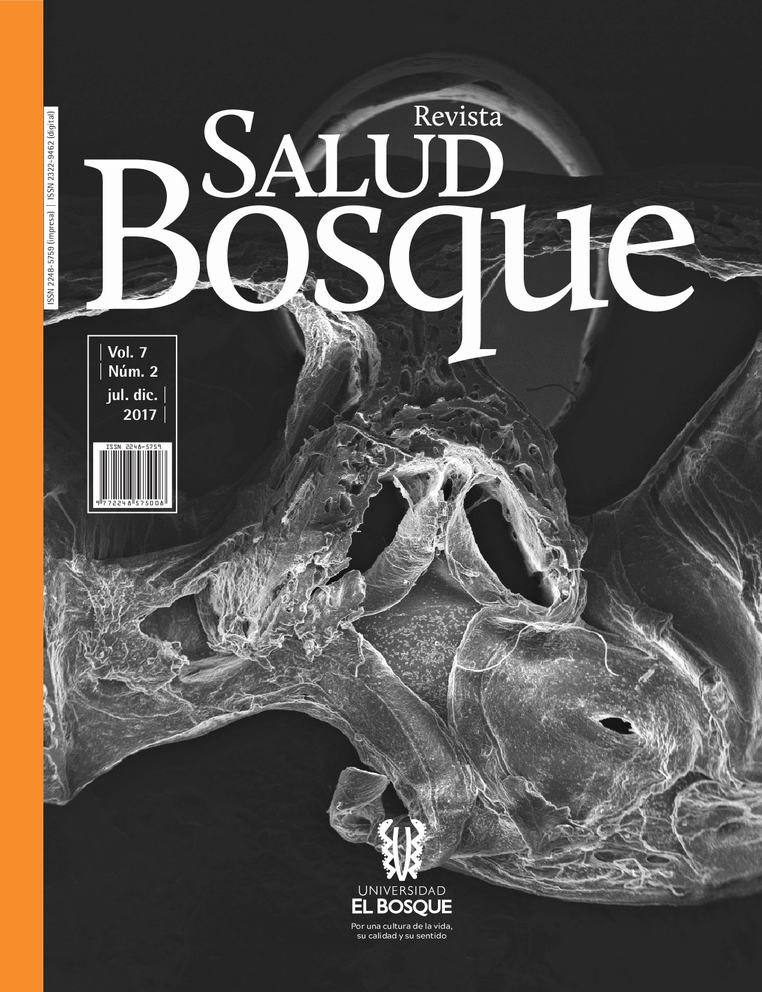La nanotecnología y los retos de sostenibilidad del sistema agroalimentario
DOI:
https://doi.org/10.18270/rsb.v7i2.2193Palavras-chave:
Nanoestructuras, Nanomateriales, Sistema agroalimentario, Seguridad alimentariaResumo
¿Pueden pequeñas cosas ayudarnos a reducir el hambre, la mala nutrición y las enfermedades transmitidas por alimentos? En realidad, la nanotecnología es al mismo tiempo un enfoque científico y un conjunto de tecnologías emergentes, tal vez las más detalladamente observadas en la historia. Actualmente, es un blanco de investigación en el cual se focalizan muchos de los recursos destinados a la financiación en ciencia, tecnología e innovación por parte de agencias públicas y privadas.
De la nanotecnología se ha dicho, por más de una década, que guarda un potencial revolucionario que abarcaría la mayoría de las actividades productivas humanas, incluyendo aquellas propias del sector agroalimentario. Este sector, del cual depende directamente el abastecimiento de alimentos y, por ende, la seguridad alimentaria, sin duda enfrenta retos extraordinarios derivados de las presiones demográficas, las limitaciones en la disponibilidad de recursos como agua, energía y tierra, las pérdidas de alimentos en las cadenas de suministro y el cambio climático.
En esta revisión se busca dar una visión introductoria a las potenciales aplicaciones de la nanotecnología relacionadas con alimentos y nutrición, en el contexto de los problemas globales de sostenibilidad. Asimismo, brinda consideraciones sobre los riesgos potenciales, el marco regulador y el rol de la nanotecnología agroalimentaria en los países en desarrollo
Downloads
Referências
Electronics.ca Research Network. Global Funding of Na¬notechnologies; 2011. Fecha de consulta: 22/02/2017. Disponible en: http://www.electronics.ca/presscenter/ar-ticles/1542/1/Annual-Global-Nanotechnology-Research- Funding-Running-at-10-Billion-Per-Year/Page1.html.
Roco MC, Bainbridge WS. Societal implications of nanoscience and nanotechnology: Maximizing human benefit. J Nanopart Res. 2005;7:1-13.
National Nanotechnology Iniatiative. What is nanotechnology? 2006. Fecha de consulta: 22/02/2017. Disponible en: www.nano.gov/html/facts/whatIsNano.html.
Dingman J. Nanotechnology: Its impact on food safety. J Environ Health. 2008;70:47-50.
Fendler JH. Self-assembled nanostructured materials. Chem Mater. 1996;8:1616-24.
Reibold M, Pätzke N, Levin AA, Kochmann W, Shakhverdova IP, Paufler P, et al. Structure of several historic blades at nanoscale. Cryst Res Technol. 2009;44:1139-46.
Ghosh SK, Pal T. Interparticle coupling effect on the surface plasmon resonance of gold nanoparticles: From theory to applications. Chem Rev. 2007;107:4797-862.
Haruta M. Catalysis: Gold rush. Nature. 2005;437:1098-9.
Kennedy LC, Bickford LR, Lewinski NA, Coughlin AJ, Hu Y, Day ES, et al. A new era for cancer treatment: Gold‐nanoparticle‐mediated thermal therapies. Small. 2011;7:169-83.
Zhong CJ, Luo J, Fang B, Wanjala BN, Njoki PN, Loukrakpam R, et al. Nanostructured catalysts in fuel cells. Nanotechnology. 2010;21:062001.
Pitkethly MJ. Nanomaterials–the driving force. Mater To¬day. 2004;7:20-9.
Tsuzuki T. Properties of nanoparticulate materials. En: Bawa R, Audette GF, Rubinstein I, editors. Handbook of Clinical Nanomedicine: Nanoparticles, imaging, therapy, and clinical applications. Boca Raton: CRC Press; 2016. p. 171-209.
Kuzma J, VerHage P. Nanotechnology in agriculture and food production: Anticipated applications. Project on Emerging Nanotechnologies; 2006. Fecha de consulta: 22/02/2017. Disponible en: http://www.nanotechproject.org/file_download/files/PEN4_AgFood.pdf
Rodrigues SM, Demokritou P, Dokoozlian N, Hendren CO, Karn B, Mauter MS, et al. Nanotechnology for sustainable food production: Promising opportunities and scientific challenges. Environ Sci-Nano. 2017;4:767-81.
Food And Agriculture Organization (FAO). The state of food insecurity in the world 2014: Strengthening the enabling environment for food security and nutrition. Rome: Food and Agriculture Organization; 2015.
McLean E, Cogswell M, Egli I, Wojdyla D, De Benoist B. Worldwide prevalence of anaemia, WHO vitamin and mineral nutrition information system, 1993-2005. Public Health Nutr. 2009;12:444.
Organización Mundial de la Salud (OMS). Nutrition topics: Controlling the global obesity epidemic. 2008. Fecha de consulta: 22/02/2017. Disponible en: http://www.who.int/ nutrition/topics/obesity/en/
Torgerson PR, de Silva NR, Fevre EM, Kasuga F, Rokni MB, Zhou XN, et al. The global burden of foodborne parasitic diseases: An update. Trends Parasitol. 2014;30:20-6.
Gruère G, Narrod C, Abbott L. Agricultural, food, and water nanotechnologies for the poor. Washington, D.C.: International Food Policy Research Institute; 2011.
Kuhlmeier D, Sandetskaya N, Allelein S. Application of nanotechnology in miniaturized systems and its use in medical and food analysis. Recent Pat Food Nutr Agric. 2012;4:187-99.
Chaudhry Q, Castle L. Food applications of nanotechnologies: An overview of opportunities and challenges for developing countries. Trends Food Sci Tech. 2011;22:595- 603.
Lu J, Bowles M. How will nanotechnology affect agricultural supply chains. Int Food Agribus Man. 2013;16:21-42.
Cozzens S, Cortes R, Soumonni O, Woodson T. Nanotechnology and the millennium development goals: Water, energy, and agri-food. J Nanopart Res. 2013;15:2001.
Kumari A, Yadav SK. Nanotechnology in agri-food sector. Rev Food Sci. 2014;54:975-84.
Pérez-Esteve E, Bernardos A, Martínez-Máñez R, M Barat J. Nanotechnology in the development of novel functional foods or their package. An overview based in patent analysis. Recent Pat Food Nutr Agric. 2013;5:35-43.
Roco MC. Broader societal issues of nanotechnology. J Nanopart Res. 2003;5:181-9.
Kuzma J. Moving forward responsibly: Oversight for the nanotechnology-biology interface. Journal of Nanoparticle Research 2007; 9:165–182.
Huang Q, Yu H, Ru Q. Bioavailability and delivery of nutraceuticals using nanotechnology. J Food Sci. 2010;75:R50-7.
Evenson R E, Gollin D. Assessing the impact of the Green Revolution, 1960 to 2000. Science. 2003;300:758-62.
Townsend AR, Howarth RW, Bazzaz FA, Booth MS, Cleveland CC, Collinge SK, et al. Human health effects of a changing global nitrogen cycle. Front Ecol Environ. 2003;1:240-6.
Lauterwasser C. Small sizes that matter: Opportunities and risks of nanotechnologies. Report in co-operation with the OECD International Futures Programme. Munchen: Allianz Center for Technology; 2006.
Wen LX, Li ZZ, Zou HK, Liu AQ, Chen JF. Controlled release of avermectin from porous hollow silica nanoparticles. Pest Manag Sci. 2005;61:583-90.
Liu Y, Yan L, Heiden P, Laks P. Use of nanoparticles for controlled release of biocides in solid wood. J Appl Polym Sci. 2001;79:458-65.
Lai F, Wissing SA, Müller RH, Fadda AM. Artemisia arborescens L essential oil-loaded solid lipid nanoparticles for potential agricultural application: Preparation and charac-terization. AAPS Pharm Sci Tech. 2006;7:E10-18.
Scrinis G, Lyons K. The emerging nano-corporate paradigm: Nanotechnology and the transformation of nature, food and agri-food systems. Int J Sociol Food Agr. 2007;15:22-44.
National Research Council (NRC). Emerging technologies to benefit farmers in sub-Saharan Africa and South Asia. National Academies Press; 2009.
DeRosa MC, Monreal C, Schnitzer M, Walsh R, Sultan Y. Nanotechnology in fertilizers. Nat Nanotechnol. 2010;5:91.
Karn B, Kuiken T, Otto M. Nanotechnology and in situ remediation: A review of the benefits and potential risks. Environ Health Perspect. 2009;117:1823-31.
Fuenmayor CA, Benedetti S, Pellicanò A, Cosio MS, Mannino S. Direct in situ determination of ascorbic acid in fruits by screen‐printed carbon electrodes modified with nylon‐6 nanofibers. Electroanal. 2014;26:704-10.
des Rieux A, Fievez V, Garinot M, Schneider YJ, Préat V. Nanoparticles as potential oral delivery systems of proteins and vaccines: A mechanistic approach. J Control Release. 2006;116:1-27.
Shi YH, Xu ZR, Feng JL, Wang CZ. Efficacy of modified montmorillonite nanocomposite to reduce the toxicity of aflatoxin in broiler chicks. Anim Feed Sci Tech. 2006;129:138-48.
Gustavsson J, Cederberg C, Sonesson U, van Otterdijk R, Meybeck A. Global food losses and food waste. Rome: Food and Agriculture Organization; 2011.
Departamento Nacional de Planeación. Pérdida y desperdicios de alimentos en Colombia. Estudio de la Dirección de Seguimiento y Evaluación de Políticas Públicas. Bogotá: Departamento Nacional de Planeación; 2016.
Fabra MJ, Busolo MA, López-Rubio A, Lagaron JM. Nanostructured biolayers in food packaging. Trends Food Sci Tech. 2013;31:79-87.
Smolander M, Chaudhry Q. Nanotechnologies in food packaging. En: Chaudhry Q, Watkins R, Castle L, editors. Nanotechnologies in Food. Cambridge: Royal Society of Chemistry; 2010. p. 86-101.
Mascheroni E, Fuenmayor CA, Cosio MS, Di Silvestro G, Piergiovanni L, Mannino S, et al. Encapsulation of volatiles in nanofibrous polysaccharide membranes for humidity-triggered release. Carbohyd Polym. 2013;98:17-25.
Schalkhammer T. U.S. Patent No. 8,257,980. Washington, D.C.: U.S. Patent and Trademark Office; 2012
Han JH, editor. Innovations in food packaging. London: Academic Press; 2005. 600 p.
Tournas VH. Spoilage of vegetable crops by bacteria and fungi and related health hazards. Crit Rev Microbiol. 2005;31:33-44.
Weiss J, Takhistov P, McClements DJ. Functional materials in food nanotechnology. J Food Sci. 2006;71:R107-16.
The Telegraph. How supercows and nanotechnology will make ice cream healthy. Aug 21, 2005.
Gomes LM, Petito N, Costa VG, Falcão DQ, de Lima Araújo KG. Inclusion complexes of red bell pepper pigments with β-cyclodextrin: Preparation, characterisation and application as natural colorant in yogurt. Food Chem. 2014;148:428-36.
Chaudhry Q, Watkins R, Castle L. Nanotechnologies in the food arena: New opportunities, new questions, new concerns. En: Chaudhry Q, Watkins R, Castle L, editors. Nanotechnologies in Food. Cambridge: Royal Society of Chemistry; 2010. p. 1-7.
Rashidi L, Vasheghani-Farahani E, Soleimani M, Atashi A, Rostami K, Gangi F, et al. A cellular uptake and cytotoxicity properties study of gallic acid-loaded mesoporous silica nanoparticles on Caco-2 cells. J Nanopart Res. 2014;16:2285.
Bazo MA, Catalán IE, Ferrero CG, Navarro CJG, Garreta JMI, Hualde AR. U.S. Patent Application 13/809,089, 2011.
Feher J. U.S. Patent Application 12/939,395, 2010.
Fuenmayor CA, Lemma SM, Mannino S, Mimmo T, Scam¬picchio M. Filtration of apple juice by nylon nanofibrous membranes. J Food Eng. 2014;122:110-6.
Kim J, Grate JW, Wang P. Nanostructures for enzyme stabilization. Chem Eng Sci. 2006;61:1017-26.
Kumar V, Guleria P, Mehta SK. Nanosensors for food quality and safety assessment. Environ Chem Lett. 2017:1-13.
Elsaesser A, Howard CV. Toxicology of nanoparticles. Adv Drug Deliver Rev. 2012;64:129-37.
Brayner R, Ferrari-Iliou R, Brivois N, Djediat S, Benedetti MF, Fiévet F. Toxicological impact studies based on Escherichia coli bacteria in ultrafine ZnO nanoparticles colloidal medium. Nano Lett. 2006;6:866-70.
Sylvester DJ, Abbott KW, Marchant GE. Not again! Public perception, regulation, and nanotechnology. Regul Gov. 2009;3:165-85.
Downloads
Publicado
Como Citar
Edição
Seção
Licença
El (Los) autor(es) certifican que es(son) el (los) autor(es) originario(s) del trabajo que se esta presentando para posible publicación en la Revista Salud Bosque de la Facultad Escuela Colombiana de Medicina de la Universidad El Bosque, puesto que sus contenidos son producto de su directa contribución intelectual.
Todos los datos y las referencias a materiales ya publicados deben estar debidamente identificados con su respectivo crédito e incluidos en las notas bibliográficas y en las citas que se destacan como tal y, en los casos que así lo requieran, deben contar con las debidas autorizaciones de quienes poseen los derechos patrimoniales.
El (Los) autor(es) declara(n) que todos los materiales que se presentan están totalmente libres de derecho de autor y, por lo tanto, se hace(n) responsable(s) de cualquier litigio o reclamación relacionada con derechos de propiedad intelectual, exonerando de responsabilidad a la Universidad El Bosque











